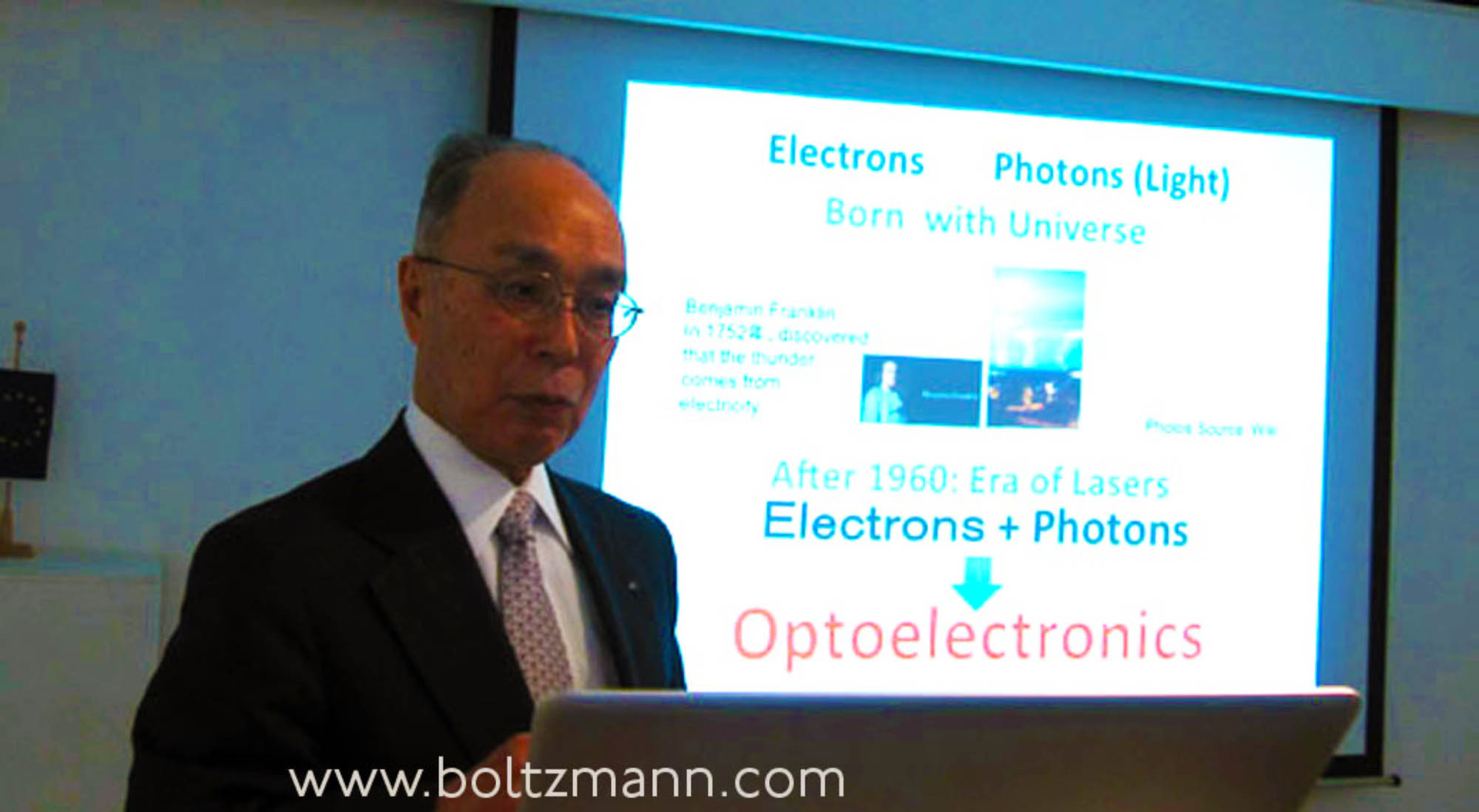VCSEL inventor Kenichi Iga: hv vs kT – Optoelectronics and Energy
(Former President and Emeritus Professor of Tokyo Institute of Technology. Inventor of VCSEL (vertical cavity surface emitting lasers), widely used in photonics systems)
Keynote presented at the 6th Ludwig Boltzmann Symposium on February 20, 2014 at the Embassy of Austria in Tokyo.
VCSEL: how Kenichi Iga invented Vertical Cavity Surface Emitting Lasers
My invention of vertical cavity surface emitting lasers (VCSEL) dates back to March 22, 1977. Today VCSEL devices are used in many applications all over the world. I was awarded the 2013 Franklin Institute Award, the Bower Award and Prize for Achievement in Science, “for the conception and development of the vertical cavity surface emitting laser and its multiple applications in optoelectronics“. Benjamin Franklin’s work is linked to mine: Benjamin Franklin in 1752 discovered that thunder originates from electricity – he linked electronics (electricity) with photons (light). After 1960 the era of lasers began, we learnt how to combine and control electrons and photons, and the era of optoelectronics.
If you read Japanese, you may be interested to read an interview with Genichi Hatakoshi and myself, intitled “The treasure micro box of optoelectronics” which was recently published in the Japanese journal OplusE Magazine by Adcom-Media.
Electrons and photons
Who are electrons? Electrons are just like a cloud expressed by Schroedinger’s equation, which Schroedinger postulated in 1926. Electrons can also be seen as randomly moving particles, described by the particle version of Schroedinger’s equation (1931).
Where does light come from? Light is generated by the accelerated motion of charged particles.
Electrons also show interference patterns. For example, if we combine the 1s and 2p orbitals around a nucleus, we observe interference.
In a semiconductor, electrons are characterized by a band structure, filled valence bands and largely empty conduction bands. The population of hole states in the valence bands and of electrons in the conduction bands are determined by the Fermi-Dirac distribution. In typical III-V semiconductors, generation and absorption of light is by transitions between 4s anti-bonding orbitals (the bottom of the conduction band) and 4p bonding orbitals (the top of the valence band).
In Japan, we are good at inventing new types of vertical structures:
- in 607, the Horyuji 5-Jyu-no Toh (5 story tower) was built in Nara, and today we have progressed to building the 634 meter high Tokyo Sky Tree Tower.
- in 1893, Kubota Co. Ltd. developed the vertical molding of water pipes
- in 1977 Shunichi Iwawaki invented vertical magnetic memory
- in 1977 Tatsuo Izawa developed VAD (vapor-phase axial deposition) of silica fibers
- in 1977 Kenichi Iga invented vertical cavity surface emitting lasers (VCSEL)
Communications and optical signal transmission
History of communications spans from 10,000 years BC with the invention of language, and 3000 BC with the invention of written characters and papyrus, to the invention of the internet in 1957, the realization of the laser in 1960, the realization of optical fiber communications in 1984, and now since 2008 we see Web 2.x and Cloud.
Optical telegraphy goes back to 200 BC, when optical beacons were used in China: digital signals using multi-color smoke. Around 600 AD we had optical beacons in China, Korea and Japan, and in 1200 BC also in Mongolia and India.
In the 18th and 19th century, optical semaphores were used in France.
In the 20th century, optical beam transmission using optical rods and optical fiber transmissions were developed, which combined with the development of lasers created today’s laser communications. Yasuharu Suematsu and his student showed the world’s first demonstration of optical fiber communications demonstration on May 26, 1963 at the Tokyo Institute of Technology, using a He-Ne laser, an electro-optic crystal for modulation of the laser light by the electrical signal from a microphone, and optical bundle fiber, and a photo-tube at the other end of the optical fiber bundle to revert the optical signals back into electrical signals and finally to drive a loud speaker. For his pioneering work, Yasuharu Suematsu was awarded the International Japan Prize in 2014.
VCSEL: I recorded my initial idea for the surface emitting laser on March 22, 1977 in my lab book.
Vertical Cavity Surface Emitting Lasers (VCSEL) have many advantages:
- ultra-low power consumption: small volume
- pure spectrum operation: short cavity
- continuous spectrum tuning: single resonance
- high speed modulation: wide response range
- easy coupling to optical fibers: circular mode
- monolithic fabrication like LSI
- wafer level probe testing
- 2-dimensional array
- vertical stack integration with micro-machine
- physically small
VCSEL have found applications in many fields, including: data communications, sensing, printing, interconnects, displays.
As an example, the Tsubame-2 supercomputer, which in November 2011 was 5th of top-500 supercomputers, and on June 2, 2011 was greenest computer of Green500, uses 3500 optical fiber interconnects with a length of 100km. In 2012: Too500/Green500/Graph500
IBM Sequoia uses 330,000 VCSELs.
Fuji Xerox introduced the first demonstration of 2 dimensional 4×8 VCSEL printer array for high speed and ultra-fine resolution laser printing: 14 pages/minute and 2400 dots/inch.
VCSEL: Some recent news:
The laser market is estimated to be US$ 11 billion by 2017.
VCSELs move to optical interconnects.
By 2019 the optical interconnect market is estimated to reach US$ 5.2 billion.
VCSEL: In summary
VCSEL photonics started from minor reputation and generated big innovation. VCSELs feature:
- low power consumption: good for green ICE
- high speed modulation beyond 20 GBits/second
- 2D array
- good productivity due to monolithic process
Future: will generate ideas never thought before.


Copyright (c) 2014 Eurotechnology Japan KK All Rights Reserved

Comments and discussions